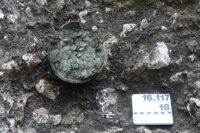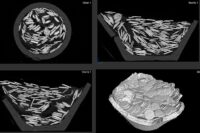 A hoard of more than 1,000 coins from the second quarter of the 4th century has been unearthed in Bubendorf, north central Switzerland. The hoard was discovered by volunteer archaeological scout Daniel Lüdin in a forested area near Wildenstein Castle. When his metal detector signaled a strong alert, Lüdin dug down a little and found a few Roman coins and some potsherds, not enough to explain the strength of the signal. He dug down a little more and hit the jackpot. Literally: a broken pot filled with coins.
A hoard of more than 1,000 coins from the second quarter of the 4th century has been unearthed in Bubendorf, north central Switzerland. The hoard was discovered by volunteer archaeological scout Daniel Lüdin in a forested area near Wildenstein Castle. When his metal detector signaled a strong alert, Lüdin dug down a little and found a few Roman coins and some potsherds, not enough to explain the strength of the signal. He dug down a little more and hit the jackpot. Literally: a broken pot filled with coins.
He filled in the hole and notified canton heritage officials at Archeologie Baselland who promptly dispatched a team to the find site. They removed the pot in a soil block so that all of the coins, pot fragments and any invisible archaeological treasures like traces of organic remains could be excavated in laboratory conditions. The block removal also allowed researchers to CT scan the soil block to map out the contents. A black space seen in the CT scans between two layers of coins turned out to be a simple piece of leather.
 The total coin count after the hoard was fully excavated is 1290 coins, all copper coins, so it was basically a change jar. It adds up, though, and the total value of 1290 coppers was the equivalent of a gold solidus, or about two months’ salary for a soldier in the legions. All of the coins were minted during the reign of Constantine (306-337 A.D.). The most recent among them date to 332-335 A.D.
The total coin count after the hoard was fully excavated is 1290 coins, all copper coins, so it was basically a change jar. It adds up, though, and the total value of 1290 coppers was the equivalent of a gold solidus, or about two months’ salary for a soldier in the legions. All of the coins were minted during the reign of Constantine (306-337 A.D.). The most recent among them date to 332-335 A.D.
What makes the hoard so unusual is that it was buried during a time of political and economic stability. Coin hoards from the 4th century were typically buried during periods of unrest, but Constantine’s reign was not among them. Hoards from this period are vanishingly rare throughout the Empire. It seems likely that this one was buried for other reasons. One possibility is a religious offering as the find site was on the border between three known Roman estates, so it could have been a boundary line sacrifice.
Here is 3D model of the hoard after the external soil was cleaned but before the contents were excavated in the laboratory.
I am so glad he covered it and left it to the pros and that they were able to pull it up in one piece. The 3 d image is amazingly interesting.
The “Limesfall” means the abandonment of the Upper Germanic-Rhaetian Limes in the mid-3rd century AD by the Romans and the withdrawal of imperial troops from the provinces on the far side of the rivers Rhine and Danube to the line of those rivers. Hence, times of “political and economic stability” were in different parts at least unsure.
The Romans controlled the “Agri Decumates” until the mid-3rd century, when the emperor Gallienus (259–260) evacuated it before the invading Alemanni and the secession of much of the Western Roman Empire under the “usurper and ruler” Postumus. Emperor Aurelian may have had them briefly reoccupied during the resurgence of the late 3rd century.
If so, the re-establishment of Roman rule was brief. After the Emperor Probus’ death (282), the region was given up and the Alemanni took control. Germanic peoples have continuously inhabited the region since then. Roman settlements were however not immediately abandoned. There is evidence the Roman way of life continued well into the 5th century.
In Bavaria, for example, bones of the presumably Roman estate family in the well of the Villa Rustica Burgweinting point to Alamannic raids in the 3rd century. The skull of a 20-30 years old decapitated woman has been hit three times by a sharp weapon and cutting marks above the right eye hole indicate that she had been scalped.